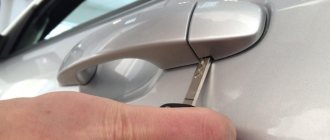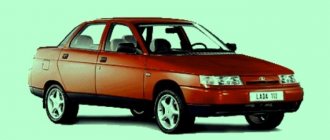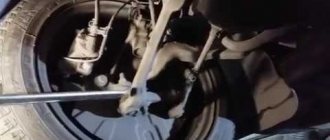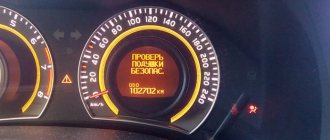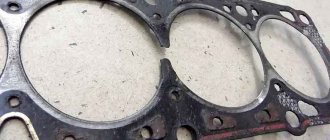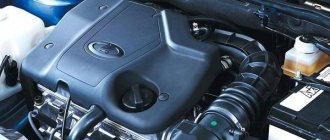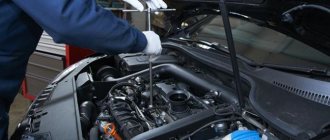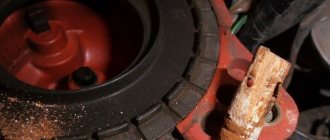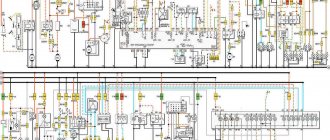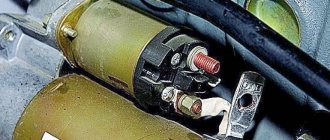Engine starting problem is a very common problem that most vehicle drivers face.
There are many reasons why your Kia Rio won't start. This could be a simple starter malfunction or more serious problems, including a faulty fuel pump or a completely discharged battery.
A little about the history of the model
The first generation of Kia Rio appeared back in 2000. Then the car was equipped with a 1.5 liter engine, 5-speed manual and 4-speed automatic. If the base engine produced only 95 hp, then the models exported to the USA were more powerful. The 1.5 l was similar, and the 1.6 l produced about 105 l/s. Models for the European market were equipped with a 1.3 liter power unit with a capacity of 75 l/s.
In 2005, the second generation appeared. Korean cars were also sold in sedan and hatchback body styles. The consumer was offered a choice of three power units:
- 1.4 liters with a capacity of 95 l/s;
- turbocharged diesel with a volume of 1.5 liters and a power of 110 l/s;
- a modernized version of the 1.6-liter engine with a power of 112 l/s.
The latest generation has been produced from 2011 to the present day. There are several powertrain options: 1.4 and 1.6 liters. The model in the basic configuration costs 650 thousand, and in the maximum configuration – 850 thousand rubles.
Why doesn't the car start?
Despite all the reliability of Korean cars, they periodically fail. There is no escape from this, although in most cases the driver is to blame for not performing vehicle maintenance on time. Nevertheless, the problem that has arisen must be solved in any case. But not every driver knows how to do this and where exactly to start.
Before looking for a solution to a problem, you need to understand its possible source. As a rule, KIA RIO does not start if there are defects in the following systems:
- fuel supply;
- ignition;
- defect in the engine or control unit.
In other cases, the KIA RIO car will start. It may not work as expected, but in 90% of cases it will be able to start. Essentially, we have three groups of reasons, each of which must be considered in more detail.
Preventing starting problems
Every Rio owner, regardless of the generation of the car and the type of transmission (manual or automatic), must clearly remember the following rules:
- The engine compartment should always be clean (this also applies to the power unit);
- it is necessary to constantly monitor the state of charge of the battery, wires, serviceability of the starter and spark plugs;
- periodically inspect the contacts and remove the oxide film and pockets of corrosion from them;
- change filters in a timely manner;
- Do not neglect carrying out scheduled maintenance at a specialized auto repair center.
It is worth emphasizing here that the unsatisfactory condition of the electrical wiring in the engine compartment is not only one of the reasons why the engine will not start, but can also cause a car fire.
Return to contents
Ignition system diagnostics
Let's consider the case when the Kia Rio catches, but does not start. In this case, the starter turns, and the battery has sufficient charge to start the engine. In the case of ignition problems, the first thing you need to do is check the spark plugs, because very often the lack of a normal spark is the main reason for the inability to start the car’s power unit.
A visual inspection is enough to understand whether it is time to change the spark plugs. If the electrodes are melted, the gap increases and the spark becomes unstable. The manufacturer recommends changing spark plugs annually or every 20,000 -30,000 kilometers. The second most popular problem is the failure of high-voltage wires. At the same time, the Kia Rio often catches, but does not start. To diagnose, simply remove the spark plug from the cylinder and, installing a third-party spark plug in it, check the spark. The breakdown can also be seen visually. Usually, on the inside of the wire at the place where the spark plugs are installed, there is a gray stripe that remains as a result of the passage of current.
Bad mass
The worse the grounding, the more problems with starting. If the battery is in order, the relay does not click and does not turn the Kia Rio starter, you need to look at the ground wires. In general, poor contact between the “mass” is a common illness among “Koreans.” The factory does not bother with the quality of the ground wires - sometimes the terminals are simply screwed on with paint. Wire 918604L200 is especially troublesome. Dirt and moisture get onto the terminals, so the contact quickly oxidizes. At some points the wire simply breaks, which is why the starter does not turn. Problems begin not only with the launch. On Kia Rio, sensors, alarms, autostart and the engine control unit itself are faulty.
Kio Rio ground wire
People struggle with the problem in different ways - someone changes the wire to a new one (factory or reinforced), someone throws additional “mass” on the body. Both methods have the right to life, so you can choose either one.
How to replace spark plugs?
This is quite easy to do on the Kia Rio. The first step is to pull off the high-voltage wires from the spark plugs, unscrew the old spark plugs and screw in the new ones. The latter are best ordered original. They have a fairly high service life and decent quality. Another important nuance is the tightening torque. It should be about 20-25 Nm. If you overtighten the spark plug, you can damage the thread so much that you will have to drill it out later. If the tightening torque is insufficient, then further unwinding from vibration is possible, which will be accompanied by tripping of the power unit. Replacing spark plugs on a Kia Rio should be done every 60,000 kilometers. But if the car is used in harsh climatic conditions or in the city, then it is better to replace it more often.
Checking the fuel system
Another possible problem is the failure of the fuel pump. The problem cannot be called typical for the Rio model. In some cases, especially when driving regularly on an empty tank, breakdowns occur quite often. It is difficult to diagnose on your own. You can, of course, replace the fuel filter, but then specialized help will be required.
It is advisable to immediately measure the pressure in the system at the fuel rail. If it is insufficient (should be 2-3 atm.), then the fuel pump or pressure regulator has failed. If the pump is in perfect order, the starter turns, but the Kia Rio does not start, then it is recommended to check the functionality of the injectors. Usually they tend to flood the spark plugs due to a change in the diameter of the nozzle due to the ingress and coking of debris from gasoline. Washing on a special stand should save the situation.
Briefly about checking the gas distribution mechanism
If at one point the Kia Rio stalls and does not start, then you should pay attention to the timing belt. Often, due to non-compliance with the regulations prescribed by the manufacturer, the belt breaks and bends the valves. Although such a breakdown is quite difficult not to notice, because it is accompanied by characteristic knocking noises in the engine.
Another thing is loosening the tension roller and loosening the belt. Because of this, the marks may get lost. If the belt jumps just one tooth, then the power unit will start, but if it jumps more, it won’t.
Often such a breakdown leads to bending of the valves. The engine needs a major overhaul; it is no longer possible to solve the problem on your own. But if the valves are intact, then it is enough to set the marks and install a new tensioner. You need to be wary of a belt break at medium and high speeds, because this always leads to valve failure. To avoid problems with the rollers jamming and the belt breaking, it is necessary to change the gas distribution mechanism kit on time.
How to open the driver's door on a Kia Rio without a key?
If the door of a Kia Rio suddenly closes, you can use several methods to solve this problem.
Before you open the Kia Rio without keys, you need to make sure that:
- no spare set of keys;
- All car windows are completely closed and cannot be used to unlock the doors.
One of the most obvious ways to open a door involves the following steps:
- creating a small gap between the driver's door and the body;
- widening the gap using scrap materials;
- prying the opening handle from the inside using a thin knitting needle or a long piece of steel wire.
This method is very effective, but it is not suitable for everyone. The key disadvantage of emergency opening by bending the door is significant damage to the body and deformation of the door.
When opening a door with a bend, it would be a good idea to have a special inflatable bulb. Such a tool is inexpensive and will be very useful if it is necessary to widen the gap. To use the pillow, you need to squeeze it into the slot and fully inflate it.
An air-filled airbag will greatly simplify access to the door or trunk lock in the event of force majeure.
If serious bending of the door is not possible, you can try this method:
- Open the door minimally.
- Use a long thin object to press the trunk handle.
- In the trunk, unscrew the bolts securing the sofa.
- Climb through the lowered sofa into the salon and open it from the inside.
With this opening option, the integrity of the body suffers much less. The only drawback of opening through the trunk is the inaccessibility of the fastening elements of the rear seats of the car.
People with large hands will find it very difficult to reach the three nuts hidden in the luggage compartment of the car.
What do the starter clicks mean?
As was said at the very beginning of the article, the problem may be completely trivial. For example, they forgot to turn off the headlights or left soft music on after work. It is quite natural that the battery will be discharged before the morning. And if the battery has already worked for several years, then this can happen without additional sources of energy consumption during a winter night. In this case, the starter simply clicks. The Kia Rio does not start in this case, which is quite logical.
The problem that has arisen can be solved in several ways - by replacing or charging the battery. If the battery dies due to the driver’s fault, then it will be enough to charge it. Modern batteries are in most cases maintenance-free, so you don’t need to add anything to them. The gentle charging mode of 2-4 amperes takes a lot of time, but allows you to completely restore energy. For example, a 60 A/h battery with a current of 5A must be charged for 12 hours. Well, replacing the battery is generally a simple matter. There are a lot of worthy manufacturers, the average service life is about 5 years, and this is if the battery is not subjected to deep discharges.
Battery and electrical circuits
A discharged battery and oxidation of the terminal contacts are the most common cause of engine failure, which is easiest to detect and eliminate without the involvement of car service specialists.
It’s easy to check the operation of the battery: there is a charge indicator on the dashboard; if there is insufficient power to initially turn the starter, its indicator will drop to zero, and the headlights will be dim.
The solution to the problem is to fully charge from a stationary charger, or while driving from a generator. In this case, the engine can be started from another battery, or you can try to directly jumper the starter if the indicator level is at least 20%. It is worth remembering that this is only permissible with a manual transmission.
A drop and loss of voltage in the electrical circuit of the power cable from the battery to the starter occurs due to the formation of oxides, contamination on the contacts or loosening of the bolted terminals. To eliminate them, it is necessary to clean the contacts on the starter and battery, checking the reliability of their connections.
Some useful tips
The manufacturer indicates clear deadlines for replacing certain consumables and servicing a wide variety of components. It is advisable to follow these tips and not leave your car unattended. A timely serviced timing belt is the key to a long life for your engine. Its resource is reduced by bad spark plugs, low quality oil and many other factors.
If the next morning the car refuses to start, then in most cases this indicates the presence of serious malfunctions, although sometimes you can get off quite easily. If the crankshaft sensor fails, then it needs to be changed in any case; there is no point in repairing it. It costs a lot, but without it there won’t even be a spark. Often the sensor remains in a “half-dead” state for quite a long time. Therefore, it happens that the Kia Rio does not start the first time. This is due to the fact that the crankshaft sensor periodically sends incorrect data to the electronic control unit, which regulates engine starting parameters.
Thick oil
It is advisable to change engine oil before winter. It's not just about wear, but also viscosity. For the winter, it is better to choose a thinner oil for Kia Rio. In winter, it is difficult for the starter to turn the crankshaft, which is in thick, frozen oil.
Motor oil viscosity
Which viscosity should I choose? You need to think correctly - not every motor can handle 0W. In the case of the Kia Rio, we look at the tolerances and see that the most “liquid” oil is 5W. Most Rio owners use 5W30 oils. Synthetics or semi-synthetics is everyone’s business.
It is important to know! Using viscous oil, the engine will experience oil starvation when starting - the lubricant cannot pass through the pump in full. After winter, seizures may form on such an engine.
What do motorists say?
Driver reviews are the most useful information that can be obtained completely free of charge. For many motorists, this is a very worthy car with a good resource, but it also loves attention. Although it is very rare for a car to refuse to start (compared to some other brands), it can still happen.
For the most part, drivers recommend paying attention to the chassis. It is quite rigid, and in conditions of poor quality road surface it fails quite quickly. Otherwise, experienced people advise changing spark plugs and oil on time, and the car will serve for a very long time. Rio rarely suffers from electrical problems, but if the “brains” are damaged, then new ones will be expensive. Naturally, without an ECU, the car will simply refuse to start.
Let's sum it up
So we have dealt with breakdowns that can lead to a lack of engine response to turning the key in the ignition switch. In fact, there are a lot of reasons for such problems. It can be simply impossible to find and eliminate them on the spot. Changing components from smaller to larger is also wrong: with such success you can go through half the car, but still not achieve a result.
It's fair to do a diagnostic first. If this is not possible, you need to look for it yourself. In practice it's not that difficult. For example, by unscrewing the spark plugs and looking at them, you can immediately understand whether fuel is being supplied at all. If yes, then you need to check the wires, and if not, the pressure in the rail, wash the injectors on the stand using ultrasound. The presence of a scanner for diagnostics significantly narrows the search range, although if the problem is mechanical, then the electronics, unfortunately, will not show it.
How to open the trunk of a Kia Rio without a key?
Sometimes the locks in a car can freeze or simply jam. We discussed how to open a car above, now we’ll figure out what to do with a closed trunk.
To solve the problem of a jammed car trunk lock, there are two effective methods:
- opening the trunk from inside the car;
- unlocking the lock from the outside.
The first option is simple and reliable. If you have access to the vehicle interior, you should simply fold down the passenger seat and reach the trunk lock with your hand.
If the keys have been forgotten or there is simply no way to open one of the car doors, a method of opening the trunk using scrap materials is ideal.
To open the lock from outside the car you will need:
- several small wooden blocks;
- screwdriver;
- a long thin object.
Opening the trunk from the outside is carried out in several stages:
- Wedging a screwdriver between the trunk lid and the body.
- Expanding the resulting gap using wooden beams of varying thickness.
- Unlocking a locked lock using a thin piece of steel wire.
In such a trunk opening scenario, the alarm will definitely go off. Therefore, you need to think in advance about how to explain your actions to the authorized body.
